#page 351
Quote
And we celebrate, too, with an unshakable smile on our lips, because we know that there, a dark-haired man sits overlooking the rows of growing rosemary, waiting for us after all these years. Letting his tea brew stronger, a book of Keats in his hand, and, most important of all, with his pulse firm and his cologne bright, and clean, and deathless.
Tripping Arcadia, Kit Mayquist
#page 351#tripping arcadia#kit mayquist#gothic#drug#drug use#suicide#classism#helena gereghty#lena gereghty#jonathan verdeau#audrey verdeau#keats#john keats#quote#quotes#literature#book#booklr#reading#IT'S FINE EVERYTHING IS FINE#THEY ALL DESERVE THE HAPPY ENDING THEY GOT#THANK YOU VERY MUCH
4 notes
·
View notes
Text

#oatsw#orion and the storm witch#comic#webcomic#blackburne#sheriff simms#William simms#page 351#intermission 2#page 9
0 notes
Text

Detonator Girls
chapter 15
page 351
1 note
·
View note
Text

Never in my life have I ever felt so much distraught and pain all at once
#do not talk to me right now I am on page 351 of all of our demise and I do not wish to talk#the way it’s 5 am I should be sleeping yet here I am crying over fictional characters#they KNOW siblings are my weakness. family dynamics are my weakness. they know. they know. they play with my emotions#genuinely emotionally tired after this like damn I…. deceased me is#all of our demise spoilers#all of our demise#all of us villains#Alistair#Hendry#the Lowe brothers are so important to me bro
144 notes
·
View notes
Text
man ive been doing great with my "read 100 pages a day" goal for like. every book ive read this year so far... EXCEPT this one 😩 i just cannot make it past 50 in one day and that is SUCH a bummer to me
#its not even that i dislike the book! because i dont!!#its just an EXTREMELY tough book to read#like man ive never really had a big issue reading 1800s prose but there is something about this particular 1800s prose thats throwing me!#i think its because it literally sounds like he took a normal sentence consulted his thesaurus and replaced 75% of the words with#bigger gaudier more pretentious fancy words fjdkfkd which makes the sentence VIRTUALLY UNREADABLE#and also some of his sentences are LONG and they just KEEP GOING#and its like my dude my guy hermy pal. nO#anyways i am on page 351 out of 522 and by GOD i want to be done with it asap but it will likely take me the rest of the week at this rate😩#siiiigh#mack reads#moby dick
5 notes
·
View notes
Text
Finding a little bloodstain in this library book and feeling an immediate connection with whoever that blood came from.
1 note
·
View note
Text
dec 18, 2023
got to spend the last day with the bf at lunch. we had lunch with mom, then he left in the afternoon- feels like such a dream honestly. i’m back in reality,, i’m sad but grateful for this weekend. i also went to tutoring for 3 hours. wasnt so bad honestly bc i took the day off of work today.
0 notes
Photo

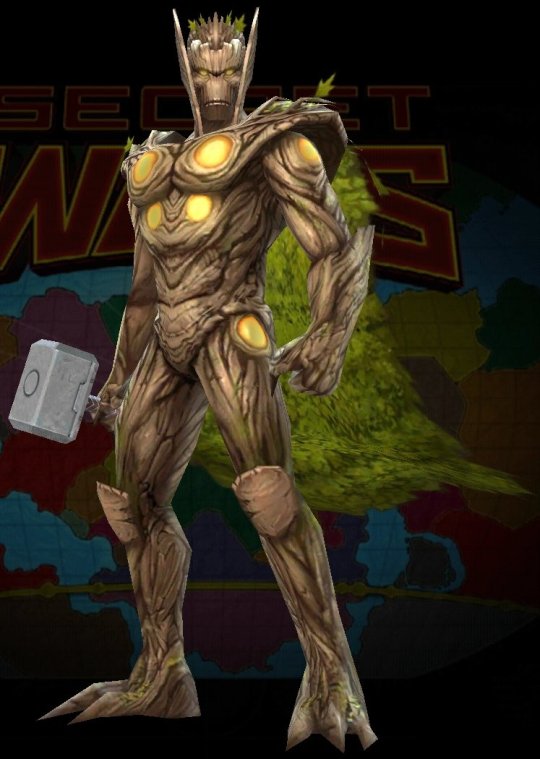
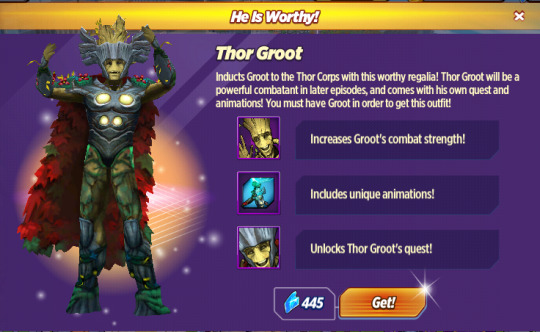

DELISTED: Thor (Groot)
weak statistical merit
editors++ nominated to delist
rejected by Summoners
↳ Wishlist: 39% upvote rate
this is a fun Groot + Thor variant, in 2 video games
but there are hundreds of more important, unique Marvel characters
The omen for this decision originally posted on twitter was a reference to an old panel in which Hulk was defeating an early version of Groot. Normally omens will be a portion of an image from a time when the delisted character was defeated or killed. However, to our editors’ knowledge, Thor (Groot) was never depicted as defeated or killed. So a fun old Groot defeat was used instead.
There are now, as of this writing, no remaining Groot variants on the Wishlist.
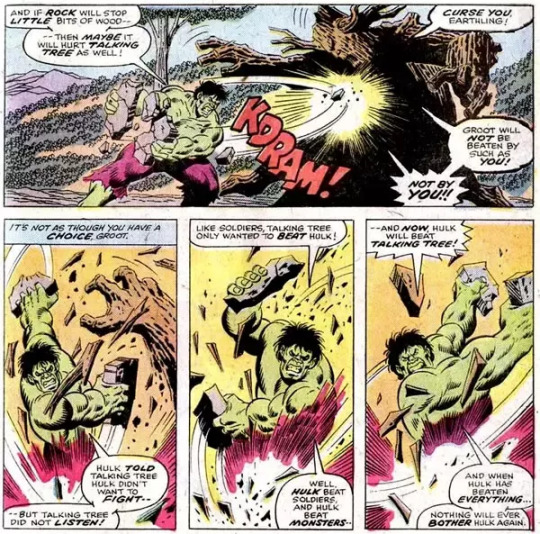
#delisted#Thor (Groot)#Groot#Thor Corps#Thors#mystic Asgardian magic#mystic relic magic hammer#Secret Wars#recent rank#MCOCW Page 15 351-375#tree#plant#alien#mcoc class mystic#mcoc class cosmic#law enforcement#other games#Marvel Future Fight#Marvel Avengers Academy#mashup#Earth-15513 Battlerealm#Battleworld#Wishlist Cleanup
1 note
·
View note
Text
dec 17, 2022
wtf happened lol. i thought the date was going well but then it ended up being too confusing for the both of us. yeah idk man. dating life is harddd
0 notes
Text
The biggest clue M. L. Rio gives us to what actually happened at the end of 'If We Were Villains' isn't Pericles, allow me to elaborate:
Spoilers for 'If We Were Villains' by M.L. Rio below, obviously.
So, everyone talks about the Pericles symbolism and that being proof that James is alive, but I think there's stronger proof elsewhere. In the epilogue, when Oliver is told that James is dead, Filippa is said to have "a copy of Winter’s Tale open in her lap" (351).
If you haven't read The Winter's Tale, that's okay, it is a strange play. (Despite it being, in my opinion, Shakespeare's most explicitly sapphic play!!). But anyway, a key aspect of the plot is that a character everyone thinks is dead comes back to life at the end. I'll explain further:
So, in act three, scene two, a character named Hermione is said to have died after being accused of a crime she didn't commit. The audience sees her pass out, and she's carried offstage where it is said she died.
Hermione was accused of adultery and treason, and the person she was accused of cheating with, Polixenes, escapes before he can be killed for this crime with an advisor named CAMILLO — aka the same name as the gang's fight coordinator who knew James well / became Fillippa's fiancé.
Now, in the very last scene of the play, all the remaining characters gather back together including Camillo, as well as Leontes, the man who caused Hermione to "die," and who was consumed by grief and regret for the actions he took that lead to her death. Miraculously, during this scene, a friend of Hermione's named Paulina reveals that through Leontes's remorse and the resolution of this whole plot, Hermione is miraculously able to come back to life. It's unclear if this is through magic or if Hermione was just hiding out with Paulina all this time and now is able to return to her husband (booooo). She falls into Leontes's arms and everyone is happy again. This is a super weird plot point and doesn't make a lot of sense, but it does speak to the possibility of James being alive!
Interestingly, from that scene, there's also this line: "Bequeath to death your numbness, for from him / Dear life redeems you." - Winter's Tale, V.iii.1280129. To me, this line can easily be applied to James's guilt and reason for theoretically committing suicide. Is James able to find redemption through dying and then coming back to life?
I think the name Camillo is the strongest connection here - there's no way it's accidental. Additionally, this might be a reach, but Winter's Tale is only mentioned one other time in the book, on page 94 when present day-Fillipa mentions, "Frederick wants to branch out and try Winter’s Tale, but Gwendolyn’s insisting on Othello.” The comparison of these two plays seems deliberate - they aren't in the same genre, so they're an odd two plays to be choosing between for the fourth years. However, there is a KEY comparison between the two: they both involve husbands becoming convinced that their wives are being unfaithful, and they both involve said husbands killing their wives—the only difference is that in The Winter's Tale, Hermione comes back to life. Desdemona doesn't. Is M. L. Rio making a sneaky reference to the two possible interpretations of her ending here? Sort of presenting the reader with a choice of what interpretation they chose to believe?
I think it's so cool!!!
#if we were villains#m l rio#james farrow#oliver marks#shakespeare#william shakespeare#dark academia#academia#iwwv#meredith dardenne#alexander vass#if we were villains spoilers
446 notes
·
View notes
Text

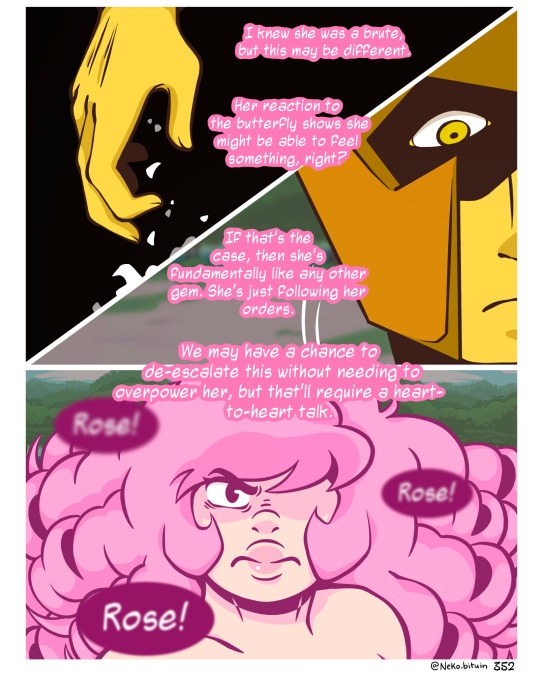



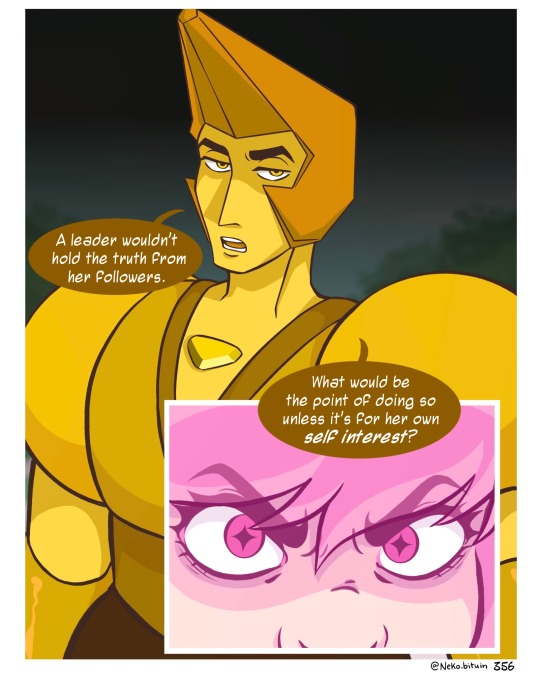

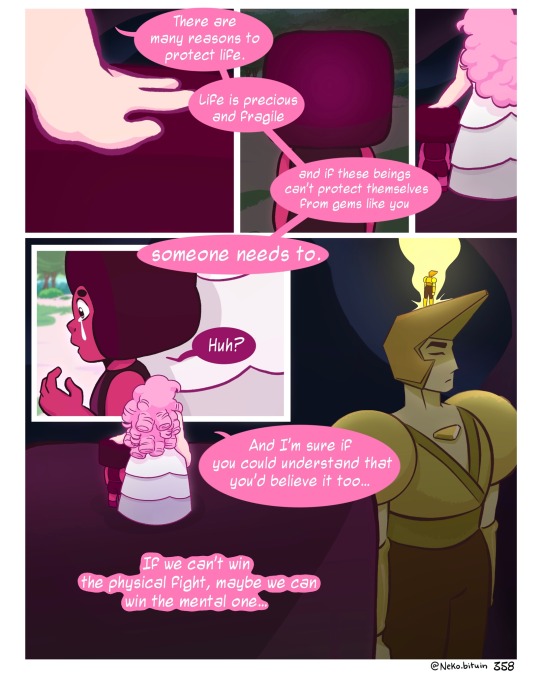


Chapter 14: A Fateful Encounter (Part 4) | Pages 351-360
<<<< Ch 14 (part 3) Ch 14 (part 5) >>>>
(Navigation Page)
(Start from the Beginning)
INSTAGRAM
* updates more frequently here
#steven universe#fracture au#su#steven universe au#fracture au series#fanart#fractureau#fan comic#my art#steven universe art
375 notes
·
View notes
Text
She has to go home and be alive and do all the things you do when you breathe and your heart beats.
Looking for Group, by Rory Harrison
#page 351#looking for group#rory harrison#young adult#YA#young adult fiction#YA fiction#queer lit#lgbtq+ lit#life#living#alive#quote#quotes#literature#book#booklr#reading
0 notes
Text
Misogyny within Wikipedia
A male Wikipedia editor reversed my edit, and I can't fight back or else risk being banned. I changed the men's-only list of French football players (titled List of France international footballers) to say List of France men's international footballers. This should be uncontroversial.
The women's page is called List of France women's international footballers.
The views the men's page got in the past 20 days, while it was titled as if it was a gender-neutral list, List of France international footballers: 175 views, 161 views, 180 views, 214 views, 220 views, 186 views, 198 views, 216 views, 220 views, 177 views, 168 views, 207 views, 228 views, 218 views, 192 views, 351 views, 378 views, 318 views, 266 views, 165 views, (then here is where I changed the name to List of France men's international footballers) 74 views.
Wikipedia purposely lies to trick people into believing List of France international footballers will be all the major footballers in France, when it is men only. The pattern in page views shows crystal clearly people are NOT searching for the men's content. When the page is properly labeled to point out it's about men's sports players, it gets FEWER VIEWS.
The worst part isn't just male Wikipedia editors deliberately lying to you. This is men in every station since the beginning of media. They have always been falsely hyping up men's sports and brushing aisde women's sports.
Not to mention this same male editor erased 2 hours and 15 minutes of my work adding a minor amount of information (linking and checking all the dates took me forever lol) to the page Football in France, because adding some short info about women threatens the men's status as the primary importance of the Football in France article. That was literally his reason for deleting. Wikipedia straight up erases information if it's about the oh so unimportant female sex.
#woso#soccer#women#women's football#women's soccer#d1 arkema#france#french women#misogyny#wikipedia#radfem#radical feminism#angry#feminism#male privilege#eugenie le sommer#selma bacha#sakina karchaoui#wendie renard#amandine henry#constance picaud#elisa de almeida#kenza dali#solene durand#delphine cascarino#estelle cascarino#grace geyoro#sandie toletti#clara mateo#kadidiatou diani
279 notes
·
View notes
Text
Every time the words I love you are said :

-Page 164

-Page 245

-Page 253

-Page 348

-Page 351

-Page 430

-Page 465

-Page 527

-Page 564
207 notes
·
View notes
Text
His fingers curled into claws, and he aimed directly for Hua Cheng's right eye!
It all happened in under a second. Hua Cheng dodged just as fast, but the attack still left two bloody scratches on his cheek.
For the first time, Hua Cheng faced an opponent he couldn't overtake in speed. His gaze turned sharp, and he changed tactics on the spot - he called forth millions of wraith butterflies, and they swarmed the man in a frenzy. The myriad butterflies wrapped the white-clad man inside a large, shimmering silver chrysalis, but that likely wouldn't last long. Hua Cheng was about to grab Xie Lian when the silver butterflies shrieked and exploded into sparkling powder!
Seeing the subtle change to Hua Cheng's expression as so many wraith butterflies were destroyed at once, Xie Lian knew that this wasn't good. The white-clad man had blown apart the wraith butterflies, and now he was hidden within the shimmering silver powder that choked the air. His newly grown hand struck out once more, aiming again for Hua Cheng's right eye!
TGCF Volume 6, page 76
In this previous post, I've speculated about the logistics of Hua Cheng being blind on his right side and his usage of the wraith butterflies as a sort of disability aid in some instances. This above scene of his first direct clash against Bai Wuxiang is another one of those moments where the text isn't directly stating something but it's possible to extrapolate from what is described and from what is implied.
Hua Cheng is extremely skilled at direct combat at a very young age already, evidenced by the way he manages to injure several of Qi Rong's lackeys when they capture him as he's only ten years old:
"I called for five or six guys, and they still couldn't catch the brat. He trashed and bit them until they were bloodied all over."
Volume 2, page 351
And then later as a young soldier in the army:
"Although the boy was carrying nothing but a worn sword, he was still highly effective and struck down many of the binu. [...] "You've never used a saber before, right? You use a sword, but the sword is tricky. Although it's fast and extremely aggressive, its range is fairly limited. If you've never used a saber before, try it next time. I think you might be even stronger with it."
Volume 3, page 124-127
(The horrifying thing about this is of course that while Hua Cheng probably possessed natural talent, the reason why he had to learn to defend himself against adults as a mere child was that he was so severely and frequently beaten by them)
Also in my previous post, I speculated that Hua Cheng always keeping his right eye covered likely meant he learned early how to compensate for his blind spot in combat, since that obvious weakness is something his opponents would immediately notice and try to take advantage of. Until Bai Wuxiang, we never witness him fighting anyone who can actually injure him, not since he's become a Supreme Ghost King. He defeats 33 heavenly officials in a row, and even fighting two against one with Feng Xin and Mu Qing, he defeats both of them with ease.
I would argue that, aside from being extremely skilled with a saber and having immense spiritual powers, it can be extrapolated from the above quote about his fight against Bai Wuxiang that it's also Hua Cheng leveraging his superior speed against his opponents that prevents them from taking advantage of his blind spot.
(As an aside, I would assume that even when Hua Cheng is in a fake skin that has both eyes and not in his true form, he's still blind in the right one because it's, well, fake. If the text ever actually contradicts that (I've not read volume 8 yet) I will add corrections)
But now, he's facing Bai Wuxiang, who is just as if not even faster than him. Judging by the fact that Bai Wuxiang aims his attack at Hua Cheng's right eye twice, he's correctly judged his blind spot to be the most vulnerable place to go for, thereby managing to bypass his defense long enough to injure him.
Hua Cheng immediately reasses the situation, realizes he needs to create more distance between himself and his opponent, and switches to use his wraith butterflies as a sort of distract-defend-attack combo. And against everyone else, this would have worked - we see this when he uses them to drive Feng Xin and Mu Qing back after they kidnapped Xie Lian away from him:
The butterfly deluge was blocked by the formless spiritual shield and shattered into shimmering silver light, which rapidly recrystallized into new silver butterflies and attacked once more. The onslaught was completely unstoppable - Feng Xin and Mu Qing gave ground slowly as they kept their shields up, and Hua Cheng steadily advanced step by step.
Volume 6, page 63
And then again to keep Feng Xin away and occupied while he faces Mu Qing with Eming:
Meanwhile, each arrow Feng Xin shot at the butterflies was snapped by their sharp wings. The sheer number of butterflies was ultimately too difficult to deal with!
Volume 6, page 64
But Bai Wuxiang is infinitely more powerful and simply destroys all the wraith butterflies at once, which then gives him the opportunity to immediately go for Hua Cheng's blind spot a second time and aim his attack there again.
If we continue to read the wraith butterflies as not only a weapon but also a disability aid of sorts, these fight scenes demonstrate both the possible uses of them as such and also their limits. While they're feared for good reason and have multiple functions - acting as his eyes and ears like spies, defending like a shield or cutting like a blade - they can help him make up for his blind spot to a certain degree, but they can't erase it. They're an aid for his vision loss, not a replacement.
(Which is a good thing imo, just to make that clear. I feel like it's always such a wasted opportunity when characters sustain a disability and then it's either magically fixed or they continue on as if they're still able-bodied. But Hua Cheng is disabled, and the ways he's found to empower himself and to navigate a world that's pretty hostile to people like him, don't take away from that)
Like I mentioned above I haven't read Volume 8 yet, where as far as I know there'll be more fight scenes, so I might come back to this post in the future to add further observations or correct previous ones!
#tgcf#rereading tgcf#hua cheng#disabled!hua cheng#I'm also gonna screencap ep 5 of the donghua to analyze his fight scenes#because watching him fight is an absolute delight#I'm just like xie lian in that way i love hua cheng and i love sword fights lmao
138 notes
·
View notes
Text
Ṣafa; Egyptian Women with coins in their hair

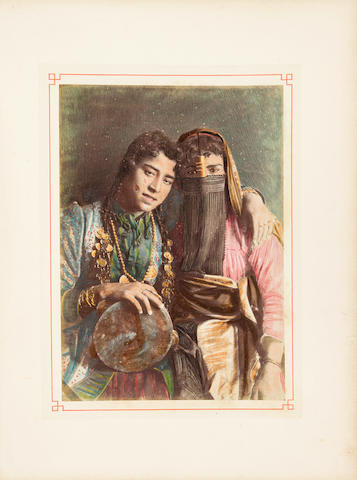



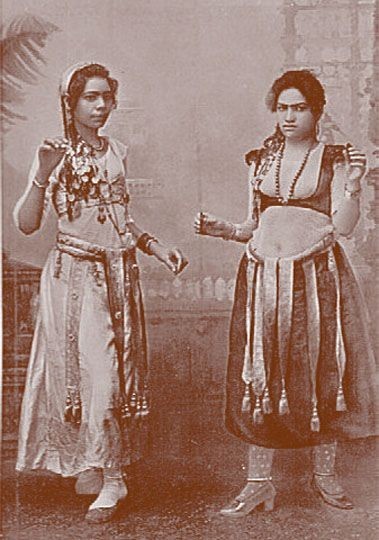
This style is attested in Edward William Lane's work from the 1830s. He describes it as follows:
The hair, except over the forehead and temples, is divided into numerous braids or plaits, generally from eleven to twenty-five in number, but always of an uneven number: these hang down the back. To each braid of hair are usually added three black silk cords, with little omaments of gold, &c., attached to them. For a description of these, which are called "ṣafa," I refer to the Appendix. Over the forehead, the hair is cut rather short; but two full locks (called "maḳàṣees"; singular "maḳṣooṣ") hang down on each side of the face: these are often curled in ringlets and sometimes plaited. (Egyptian women swear by the side-lock (as men do by the beard), generally holding it when they utter the oath, "Wa-ḥayát maḳṣooṣee!") [Page 45-46]
Further detail comes from an appendix focusing on jewelry:

It has been mentioned that all the hair of the head, except a little over the forehead and temples, is arranged in plaits, or braids, which hang down the back. These plaits are generally from eleven to twenty-five in number; but always of an uneven number: eleven is considered a scanty number: thirteen and fifteen are more common. Three times the number of black silk strings (three to each plait of hair, and each three united at the top), from sixteen to eighteen inches in length, are braided with the hair for about a quarter of their length; or they are attached to a lace or band of black silk which is bound round the head, and in this case hang entirely separate from the plaits of hair, which they almost conceal. These strings are called "ḳeyṭáns" and together with certain ornaments of gold, &c., the more common of which are here represented, compose what is tenned the "ṣafa". Along each string, except from the upper extremity to about a quarter or (at most) a third of its length are generally attached nine or more of the little flat ornaments of gold called "barḳ." These are commonly all of the same form, and about an inch, or a little more, apart; but those of each string are purposely placed so as not exactly to correspond with those of the others. The most usual forms of barḳ are Nos. 1 and 2 of the specimens given above. At the end of each string is a small gold tube, called "másoorah," about: three-eighths of an inch long, or a kind of gold bead in the form of a cube with a portion cut off from each angle, called "ḥabbeh." Beneath the másoorah or ḥabbeh is a little ring, to which is most commonly suspended a Turkish gold coin called "Ruba Fenduḳlee," equivalent to nearly 1s. 8d. of our money, and a little more than half an inch in diameter. Such is the most general description of ṣafa ; but there are more genteel kinds, in which the ḥabbeh is usually preferred to the másoorah, and instead of the Ruba Fenduḳlee is a flat ornament of gold, called, from its form, "kummetrè," or "pear." There are also other and more approved substitutes for the gold coin; the most usual of which is called "shiftisheh," composed of open gold work, with a pearl in the centre. Some ladies substitute a little tassel of pearls for the gold coin; or suspend alternately pearls and emeralds to the bottom of the triple strings; and attach a pearl with each of the barḳ. The ṣafa thus composed with pearls is called "ṣafa loolee.'' Coral beads are also sometimes attached in the same manner as the pearls. From what has been said above, it appears that a moderate ṣafa of thirteen plaits will consist of 39 strings, 351 barḳ, 39 másoorahs or ḥabbehs, and 39 gold coins or other ornaments; and that a ṣafa of twenty-five plaits, with twelve barḳ to each string, will contain no fewer than 900 barḳ, and seventy-five of each of the other appendages. The ṣafa appears to me the prettiest, as well as the most singular, of all the ornaments worn by the ladies of Egypt. The glittering of the barḳ, &c., and their chinking together as the wearer walks, have a peculiarly lively effect. [Page 572-574]
He goes onto describe a similar style worn by poorer women, but I probably will do its own post because it was still being worn in the Western Oases near the 1970s, and really doesn't use coins or barḳ.
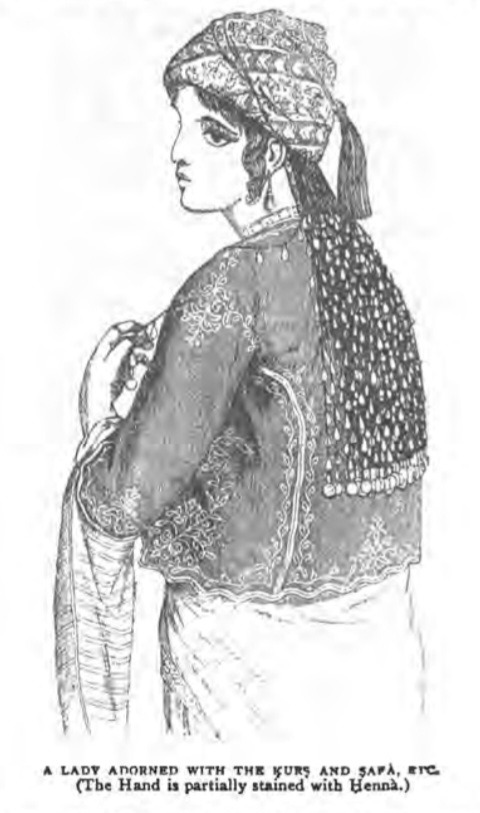

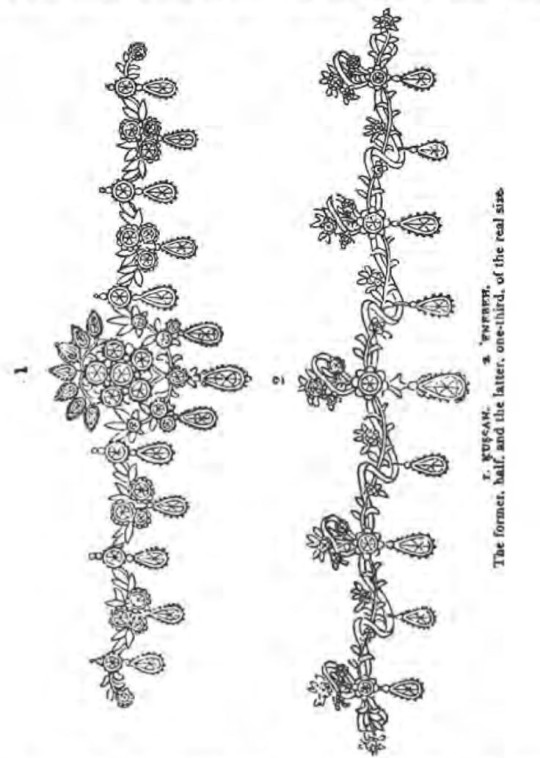
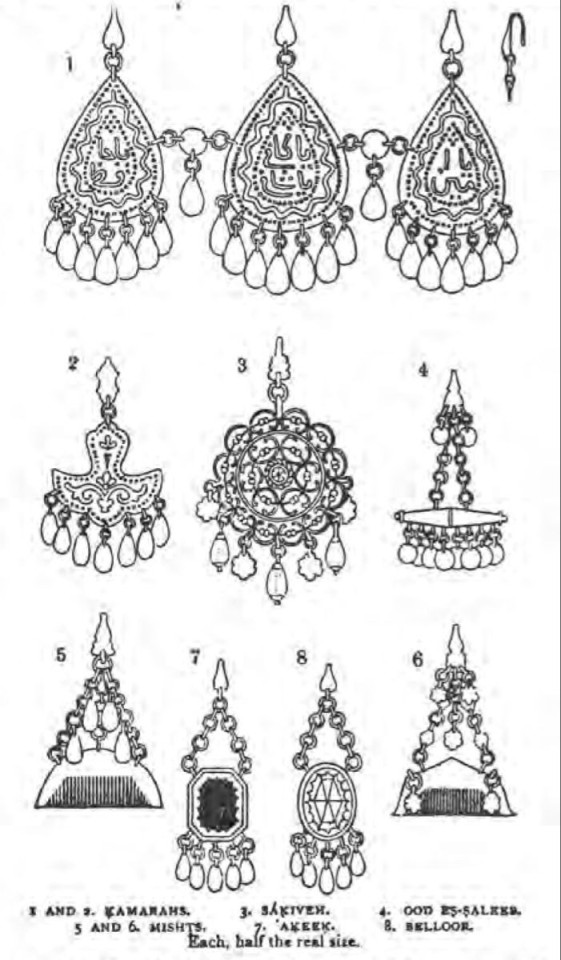
This hairstyle initally was also worn with a particular headdress of upper and middle class Egyptian women, called a rabṭah, which is essentially a woman's turban. It is made with a tarboosh or ṭáḳeeyeh (I think Lane might mean taqiyah) as the base, with muslin printed or painted scarves called faroodeeyeh, or crepe scarves wrapped around it in a high, flat pattern. Over the tarboosh was stitched down an ornament called a ḳurṣ, made of metal and often gems, and distinguished by material- generally wether it was made of diamonds (ḳurṣ almás) or of gold (ḳurṣ dahab), with the latter often having an emerald or ruby cabochon in the center. A ḳuṣṣah/'enebeh (items similar to the Algerian khit errouh) or shawáṭeḥ (worn in the same manner, but made of pearl strands or netted beading with an emerald in the center) may also be attached, as well as many other small pendants and pins. It sometimes also had silver or gilt spangles attached to the front, in which case the rabṭah was made of rose or black muslin or crepe.
As can be seen from the sharper photos of bare headed women, the braids themselves start a few inches away from the scalp, not directly at it, probably owing to the texture of most of these women's hair.
While initally as Lane describes, this was a hairstyle for the middle and upper class, as those classes began to look increasingly at European fashions under the Khedivate and British Occupation, the hairstyle mainly continued use among the poor, dancers, and some Beoduins.
This style of many braids with bangs and often a turban over top is potentially rather old in Ottoman Turkish art, with examples appearing from the 17th century- though they are unfortunately unclear, as they could also be stylized tendrils of hair, and in some cases, clearly are such.

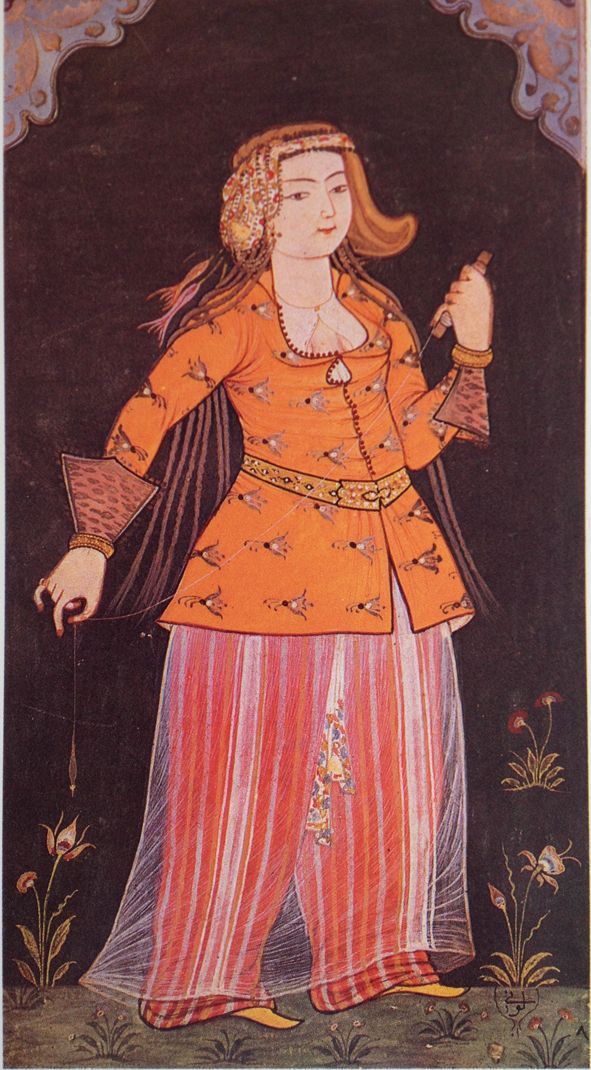

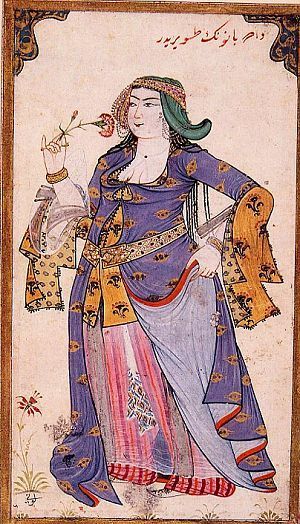
Similar styles of many long braids started a few inches away from the scalp are still used in Turkic groups such as Uzbeks and Uyghurs, particularly while wearing folk dress.
Sources/further reading:
Edward William Lane, The Manners and Customs of the Modern Egyptians.
Heather D. Ward, Egyptian Belly Dance in Transition: The Raqs Sharqi Revolution, 1890-1930
Unfortunately I don't have more to offer you, even for the Turkish style.
106 notes
·
View notes